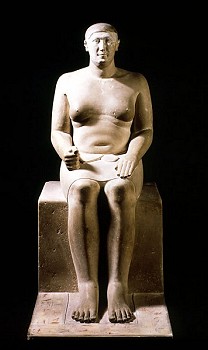
A term derived from Arabic for the highest official in the land, responsible for the daily running of affairs. He was appointed by the king and was accountable only to the latter. The title appears as early as the Old Kingdom, or perhaps slightly earlier. In the 4th Dynasty the vizier was a son of the king; from the 5th Dynasty on this was no longer the case. In the Old Kingdom the power of the vizier reached as far as Aswan, but in the Middle Kingdom it also encompassed Lower Nubia. When the border was moved even further south in the New Kingdom, Nubia came under the control of a viceroy who was independent of the vizier, the King's Son of Kush. There was originally only one vizier for all of Egypt, but as time progressed the office was divided with one vizier having control over Upper Egypt and the other over Lower Egypt. It is assumed, sometimes on very shaky evidence, that this was already the case for some periods of the Old Kingdom (the reign of Pepi II), the Middle Kingdom (under Senwosret I) and the 2nd Intermediate Period, but firm proof of the division only exists from the New Kingdom on, at least from the reign of Tuthmosis III. Each vizier was responsible for his own part of the country, and it appears that the two functioned virtually independently of each other. The residence of the northern vizier was the city of Memphis (in the 19th Dynasty also Piramesse in the Delta). His southern colleague was based in Thebes. The installation ceremony and duties of the vizier have been preserved for us in texts recorded on the walls of the tombs of several New Kingdom viziers, such as that of Rekhmire, who lived during the reign of Tuthmosis III. These protocols show that the tasks of the vizier were extremely extensive. He was the king's deputy and his main task was the governing of the country, including supervision of the storage areas and treasuries, granaries and all the scribes of royal documents. The extensive document archive also fell under his authority. All the officials in the country were accountable to the vizier. In the Old Kingdom the vizier was also the supervisor of the pyramid town, and from the 4th Dynasty on the Overseer of Royal Works, which included the royal tomb. In the New Kingdom he was in charge of the village of Deir el-Medineh, where the workers on the royal tombs lived, and was responsible for their well being. His influence also covered the shipping traffic and the temples and their priests as well as the offerings; sometimes the vizier also bore priestly titles. His duties also encompassed a number of legal instances. He was not only the chief of 'police' (maintaining the order of creation, the principle of Maat), but he also played an important role in legal processes, for instance in the trial of the tomb robbers in the Valley of the Kings in the late New Kingdom. The power of the vizier only began to decline in the Late Period.